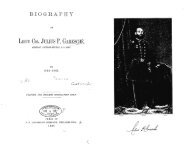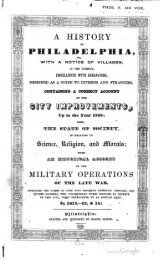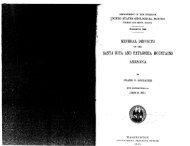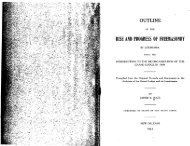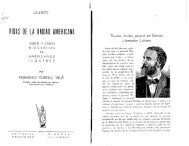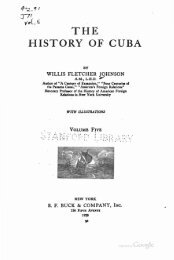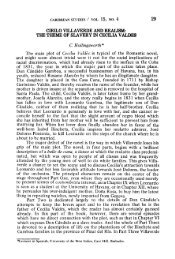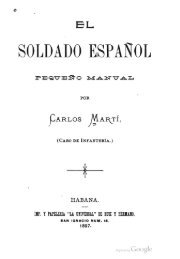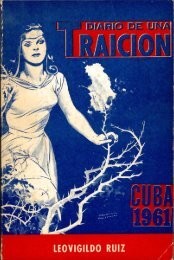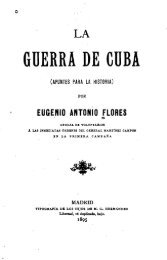Areas and Periods of Culture in the Greater Antilles
Areas and Periods of Culture in the Greater Antilles
Areas and Periods of Culture in the Greater Antilles
Create successful ePaper yourself
Turn your PDF publications into a flip-book with our unique Google optimized e-Paper software.
256<br />
SOUTHWESTERN<br />
JOURNAL OF ANTHROPOLOGY<br />
Among <strong>the</strong> types <strong>of</strong> artifacts associated with Cuevas <strong>and</strong> Cuevas-like pottery<br />
are clay griddles, used for bak<strong>in</strong>g cassava; adzes, celts, <strong>and</strong> hammers <strong>of</strong> stone;<br />
<strong>and</strong> a variety <strong>of</strong> stone, bone, <strong>and</strong> shell ornaments. These have been found only <strong>in</strong><br />
refuse, never <strong>in</strong> association with ball courts or <strong>the</strong> o<strong>the</strong>r ceremonial structures <strong>of</strong><br />
<strong>the</strong> historic Indians. Representations <strong>of</strong> <strong>the</strong> zemis, which <strong>the</strong> later Indians worshipped,<br />
are also lack<strong>in</strong>g, <strong>and</strong> it is <strong>the</strong>refore <strong>in</strong>ferred that <strong>the</strong> Arawak came <strong>in</strong>to<br />
<strong>the</strong> <strong>Antilles</strong> without <strong>the</strong> elaborate ceremonial complex which characterized <strong>the</strong>m<br />
<strong>in</strong> <strong>the</strong> time <strong>of</strong> Columbus.34<br />
<strong>Periods</strong> Illa <strong>and</strong> IIIb. Four ceramic styles have so far been def<strong>in</strong>ed for<br />
<strong>Periods</strong> IIIa <strong>and</strong> IIIb: Ostiones <strong>and</strong> Santa Elena <strong>in</strong> Puerto Rico, Meillac <strong>in</strong> Haiti,<br />
<strong>and</strong> Bani <strong>in</strong> Cuba (Fig. 2). Ostiones potsherds are technologically almost as good<br />
as <strong>the</strong> previous Cuevas ceramics, <strong>and</strong> <strong>the</strong>y reta<strong>in</strong> many <strong>of</strong> <strong>the</strong> latter's dist<strong>in</strong>ctive<br />
traits, such as rectangular lugs <strong>and</strong> <strong>the</strong> pa<strong>in</strong>t<strong>in</strong>g or polish<strong>in</strong>g <strong>of</strong> restricted surfaces.<br />
On <strong>the</strong> o<strong>the</strong>r h<strong>and</strong>, bowls are ma<strong>in</strong>ly straight-sided <strong>in</strong>stead <strong>of</strong> bell-shaped; h<strong>and</strong>les<br />
are looped over <strong>the</strong> rim ra<strong>the</strong>r than D-shaped; <strong>and</strong>, on <strong>the</strong> sherds <strong>of</strong> Period IIIb,<br />
<strong>the</strong> decoration is enriched by <strong>the</strong> addition <strong>of</strong> modeled head-lugs <strong>and</strong> curvil<strong>in</strong>ear<br />
<strong>in</strong>cised designs. It is difficult to dist<strong>in</strong>guish <strong>the</strong> earliest specimens from Cuevas<br />
pottery, but as one proceeds upwards through <strong>the</strong> refuse <strong>of</strong> <strong>Periods</strong> IIIa <strong>and</strong> IIIb,<br />
<strong>the</strong> differences <strong>in</strong>tensify, as if a gradual local development had taken place.35<br />
Santa Elena sherds are coarser <strong>and</strong> thicker than <strong>the</strong> Ostiones specimens,<br />
pa<strong>in</strong>t<strong>in</strong>g is not so common, <strong>and</strong> <strong>in</strong>cision is largely limited to simple, straight-l<strong>in</strong>e<br />
designs, <strong>the</strong> most typical <strong>of</strong> which is a series <strong>of</strong> vertical grooves on <strong>the</strong> outer<br />
surface <strong>of</strong> <strong>the</strong> vessel wall. The grooves are <strong>of</strong>ten bordered on one side by a<br />
vertical strip <strong>of</strong> clay, which appears to be a vestigial h<strong>and</strong>le. Large, modeled head-<br />
lugs are also present. Santa Elena pottery resembles closely that <strong>of</strong> <strong>the</strong> Magens<br />
Bay-Salt River group <strong>of</strong> sites <strong>in</strong> <strong>the</strong> Virg<strong>in</strong> Isl<strong>and</strong>s, <strong>and</strong> <strong>the</strong>re is reason to believe<br />
that it may have been <strong>in</strong>troduced <strong>in</strong>to Puerto Rico by people com<strong>in</strong>g from that<br />
isl<strong>and</strong> group <strong>and</strong> replac<strong>in</strong>g <strong>the</strong> local, Ostiones Indians on <strong>the</strong> eastern end <strong>of</strong><br />
Puerto Rico (Fig. 2) 36<br />
In <strong>the</strong> Dom<strong>in</strong>ican Republic, to <strong>the</strong> west <strong>of</strong> Puerto Rico, <strong>the</strong> pottery <strong>of</strong> <strong>the</strong><br />
Anadel <strong>and</strong> San Juan sites, which appear to date from <strong>Periods</strong> IIIa <strong>and</strong> IIIb,<br />
has close resemblance to <strong>the</strong> Ostiones ceramics <strong>of</strong> Puerto Rico.37 Similar specimens<br />
occur as a m<strong>in</strong>ority ware <strong>in</strong> both Haiti38 <strong>and</strong> Jamaica.39 S<strong>in</strong>ce <strong>the</strong>se specimens<br />
34 Rouse, MSa.<br />
35 Rouse, MSa.<br />
36 Hatt, 1924; Rouse, MSa.<br />
37 Krieger, 1929, pl. 25; 1930, pl. 31, top.<br />
38 Rouse, 1939, pp. 94-95; 1941, pl. 25: 18-25.<br />
39 Personal communication from Mrs Marian de Wolf.



